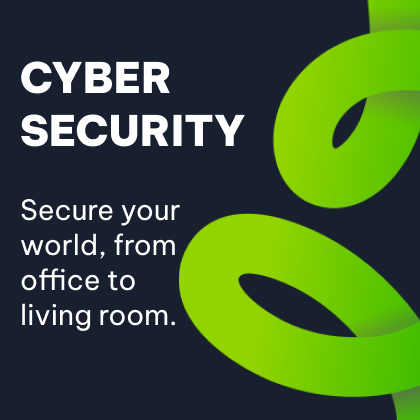Cyber attacks on small businesses are on the rise – why SMEs are more vulnerable to cyberattacks, and how to stay safe
When we think of cyberattacks, we often picture a giant corporation with hackers trying to break into a billion-dollar cyberdeck (we blame the movies). The truth, however, lies on the opposite end of the spectrum – cyberattacks on small businesses are rising.
Thi is mainly because many SMEs have limited budgets, outdated systems and minimal staff training. Put simply: attackers go where the doors are easiest to open.
Think of it like this: large corporates invest heavily in security teams and layers of protection. Smaller businesses are often leaner, making them attractive targets for opportunistic hackers. Below we explain why, and give practical, affordable steps you can implement right away.
Why small businesses are vulnerable to cyber attacks
Limited budget = limited defence: Large firms can afford dedicated security teams, regular audits and enterprise-grade tools. Most SMEs operate on tight margins, so security is often deferred. That can mean unpatched systems, basic antivirus only and no 24/7 monitoring — an invitation to attackers.
A false sense of security: Many small business owners assume they’re “too small to matter”. In reality, cyber criminals treat SMEs as low-effort, high-reward targets. Simple breaches multiplied across dozens of businesses still pay off.
Human error and lack of training: All it takes is a click. Yup. Just one innocent click from a person who doesn’t know better can take down an entire organisation. Employees without regular training often can’t spot scams, dangerous links, or social engineering tricks. Good habits are the frontline defence.
Weak Passwords and Outdated Systems: Is your team still using the hand-me-down PC that needed replacing about 4 years ago? And when was the last time anyone – ANYONE – updated their software? Nothing screams entry point like an unpatched system. Combine this with weak or recycled passwords, and you’ve basically left the front door open. Attackers scan for known vulnerabilities — if your systems aren’t updated, you’re presenting an easy route in.
Practical Steps Every SME Can Take Today
You don’t need a military-grade budget to reduce risk. Adopt these practical measures and you’ll significantly lower your exposure to cyberattacks on small businesses.
Maintain cyber hygiene
- Keep operating systems and applications up to date.
- Apply security patches promptly.
- Use a password manager and enforce strong, unique passwords.
- Enable multi-factor authentication (MFA) for all critical accounts.
Train your people regularly
- Run short, frequent sessions on spotting phishing emails, suspicious links and safe browsing.
- Make cybersecurity part of employee onboarding and monthly refreshers.
Backup and test backups
- Use both cloud and offline backups for critical data.
- Test restores regularly so you know your backups work when you need them.
Invest sensibly
- Move beyond free antivirus. Affordable endpoint protection, email filtering and a good firewall make a big difference.
- Consider managed security services if you don’t have in-house expertise — they can be cost-efficient for SMEs.
Have an incident response plan
- Know who to call and what steps to take if you detect a breach.
- Assign responsibilities, contact details and a communication plan to minimise disruption.
Quick Checklist — Low-Cost Steps to Reduce Risk Now
- Update all systems and software this week
- Enable MFA on business email and admin accounts
- Start monthly phishing-awareness emails/trainings
- Implement a password manager and roll out strong passwords
- Schedule automatic daily backups and test restores monthly
- Put an incident response contact list where staff can find it
It’s not that small businesses don’t face the same threats as larger ones, but rather they face them with far fewer defences – which is exactly what makes them such attractive targets. However, by combining the correct mindset with easy, practical steps, you can go a long way to reducing this vulnerability.
You don’t need to build Fort Knox – you just have to make sure your doors are locked in order to sleep at night.
Stay safe, stay secure, and stay cyber smart.
Vox has partnered with global cybersecurity experts Sophos for cybersecurity solutions and we are easily able to cater to the needs of SMEs – contact us to find out more.
Some Frequently Asked Questions
Are small businesses at greater risk of cyberattacks?
Yes. Many small businesses have fewer security resources and less training, making them easier targets. Attackers often target SMEs for the same reasons they target larger firms: for data, money or to use compromised systems as launch points.
What types of cyberattacks target SMEs?
Common attacks include phishing emails, ransomware, credential theft, business email compromise (BEC) and unpatched software exploits. Phishing and ransomware are particularly damaging for small businesses.
How much should an SME spend on cybersecurity?
There’s no one-size-fits-all number. Start with basic protections (patching, backups, MFA, endpoint security) and scale from there. Many affordable solutions and managed services are tailored to SME budgets.
How often should employees be trained?
Short, regular sessions (quarterly or monthly refreshers) are ideal. Frequent reminders, simulated phishing tests and clear reporting steps help keep awareness high.
What should I do immediately after a cyberattack?
Disconnect affected systems if safe to do so, preserve logs where possible, notify your IT/security provider and follow your incident response plan. Report significant breaches to relevant authorities and affected parties as required.
Are backups enough to protect my business?
Backups are essential but not sufficient on their own. They protect your data from loss and ransomware, but you also need preventive measures (patching, MFA, endpoint protection) and an incident response plan.

















